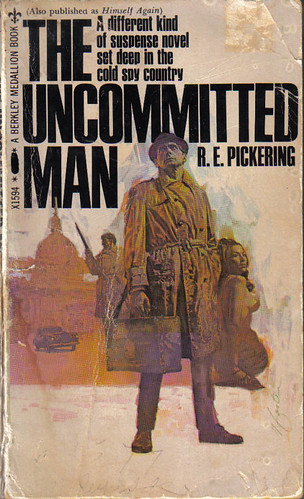Thursday, November 29, 2007
Everybody's Doin' It Now
"Everybody's Doin' it" by Commander Cody and His Lost Planet Airmen, has hit the top of the charts in the Spacebeer/Dr. Mystery household. It is featured prominently in Joe Dante's first film, Hollywood Boulevard (made for Roger Corman), which he co-directed in 1976 with Allan Arkush, the guy that made Rock and Roll High School. I will argue that it is possibly the best non-sequitur musical interlude / love scene committed to film. Just listen to a few times and see if you can stop singing it.
Tuesday, November 27, 2007
But not as brightly lit...
This week Josh and I finished a year-long project of watching every single last episode of Tales from the Darkside. A project well worth the effort I might add. I love comeuppance as a plot device, and 91% of Tales from the Darkside episodes feature comeuppance prominently.
It is impossible for me to pick a favorite, so enjoy the intro (which makes me happy and excited the same way that the intro to Twin Peaks does), and then watch a bunch of YouTube clips here.
It is impossible for me to pick a favorite, so enjoy the intro (which makes me happy and excited the same way that the intro to Twin Peaks does), and then watch a bunch of YouTube clips here.
Monday, November 26, 2007
Children of the Lens
 The last official book of the Lensman series (again, nicely lent by the lovely choo) is Children of the Lens (serialized in 1947/48, published in hardcover in 1954). In this book, the long work of the Arisian master race is finally realized with the off-spring of Kim and Clarissa Kinnison. Their son, Kit, and two sets of twin daughters (who of course all have red hair), are the world's only third-stage lensman, and with their combined powers have minds even stronger than those of their mentors.
The last official book of the Lensman series (again, nicely lent by the lovely choo) is Children of the Lens (serialized in 1947/48, published in hardcover in 1954). In this book, the long work of the Arisian master race is finally realized with the off-spring of Kim and Clarissa Kinnison. Their son, Kit, and two sets of twin daughters (who of course all have red hair), are the world's only third-stage lensman, and with their combined powers have minds even stronger than those of their mentors.As the novel opens, the fight between good and evil has really heated up the universe, and only the combined strength of the first, second, and third stage lensmen can save it, mostly through a series of interconnecting adventures. In one such quest, Kim Kinnison takes on the persona of Sybly Whyte, a hacky (but popular) author of space-opera novels and schlocky journalism. The section Smith gives us of one of Whyte's books is some of the best science-fiction satire ever:
Qadgop the Mercotan slithered flatly around the after-bulge of the tranship. One claw dug into the meters-thick armor of pure neutronium, then another. Its terrible xmex-like snout locked on. Its zymolosely polydactile tongue crunched out, crashed down, rasped across. Slurp! Slurp! At each abrasive stroke the groove in the tranship's plating deepened and Qadgop leered more fiercely. Fools! Did they think that the airlessness of absolute space, the heatlessness of absolute zero, the yieldlessness of absolute neutronium, could stop QADGOP THE MERCOTAN? And the stowaway, that human wench Cynthia, cowering in helpless terror just beyond this thin and fragile wall...
Children of the Lens is a little more disjointed than its predecessors, mostly because we are following the adventures and quests of five children, two parents, and three other second-stage lensmen, instead of focusing most of our attention on Kim Kinnison and his work. Spreading the adventure out among a larger cast of characters does nothing to lessen the excitement, however. Children of the Lens provides a satisfying and fun to read conclusion to the Lensman saga.
And there is still Masters of the Vortex, a seventh novel by Smith that takes place in the Lensman universe, but isn't part of the story arc explored in these first six books. And of course I'm going to read it.
Go Lensmen!
[Oooh, and you have to check out this fold-out ad for a science fiction bookclub that was tipped in to the middle of the book. My favorite part is the fold-together envelope that you use to send in your dime for your trial membership.]
Wednesday, November 21, 2007
Glinda of Oz
 I'm done! Last week I finished reading every word of this book, finishing it all off with the last of the Oz books written by L. Frank Baum (and the second published posthumously), Glinda of Oz; In Which Are Related the Exciting Experiences of Princess Ozma of Oz, and Dorothy, in Their Hazardous Journey to the Home of the Flatheads, and to the Magic Isle of the Skeezers, and How They Were Rescued from Dire Peril by the sorcery of Glinda the Good (1920). Or just Glinda of Oz for short.
I'm done! Last week I finished reading every word of this book, finishing it all off with the last of the Oz books written by L. Frank Baum (and the second published posthumously), Glinda of Oz; In Which Are Related the Exciting Experiences of Princess Ozma of Oz, and Dorothy, in Their Hazardous Journey to the Home of the Flatheads, and to the Magic Isle of the Skeezers, and How They Were Rescued from Dire Peril by the sorcery of Glinda the Good (1920). Or just Glinda of Oz for short.This is one of the strongest of the late-period Oz books, and makes for a rather nice adventure story and a satisfying (if unplanned) end to the series.
In this book, Ozma and Dorothy learn of two groups far off in the unexplored regions of Oz, the Flatheads and the Skeezers, who are preparing to go to war against one another. The Flatheads live on a mountain and have, well, flat heads. Because their heads are flat, they have no room for a brain, and were instead each given one brain in a jar that they carry around with them. This set-up makes it possible for the king (named Su-Dic, which is short for supreme dictator) and queen to confiscate other Flathead's brains and make themselves the smartest of their race so they can never lose power. The Skeezers live in the middle of a lake in a beautiful glass dome. They are ruled by a vain queen named Coo-ee-oh. Both groups have 101 citizens and are mad at each other for a wide variety of reasons, mostly involving the vanities of their leaders and the misuse of magic.
The Flatheads and the Skeezers are so isolated that they don't even know they are part of Oz, and have never heard of Ozma or her rules against using magic in the kingdom. Because it is Ozma's job to keep peace in Oz, she and Dorothy decide to travel to this corner of Oz and negotiate peace between the two groups and introduce them to the wonderfulness of Ozma's leadership.
 Glinda is initially unsure about this, since it would be terrible for all the people in Oz if Ozma or Dorothy were hurt. Since Ozma is a fairy, she is relatively safe, but Dorothy is a different story:
Glinda is initially unsure about this, since it would be terrible for all the people in Oz if Ozma or Dorothy were hurt. Since Ozma is a fairy, she is relatively safe, but Dorothy is a different story:The very fact that Dorothy lived in Oz, and had been made a Princess by her friend Ozma, prevented her from being killed or suffering any great bodily pain as long as she lived in that fairyland. She could not grow big, either, and would always remain the same little girl who had come to Oz, unless in some way she left that fairyland or was spirited away from it. But Dorothy was a mortal, nevertheless, and might possibly be destroyed, or hidden where none of her friends could ever find her. She could, for instance be cut into pieces, and the pieces, while still alive and free from pain, could be widely scattered; or she might be buried deep underground or "destroyed" in other ways by evil magicians, were she not properly protected. These facts Glinda was considering while she paced with stately tread her marble hall.
As you might expect, the two girls get in a bit over their heads when trying to work things out between the Flatheads and the Skeezers, but after quite a few adventures, and with a little help from their friends and the magic of Glinda and the Wizard of Oz, peace is eventually restored to the kingdom.
[Oooh, and you can view some images of the original manuscript here, thanks to the Library of Congress. Yay archives!]
[Read the whole thing here! It is good!]
Tuesday, November 20, 2007
What is gross:
Waking up in the morning and going into the bathroom to pee, but when you lift up the lid of the toilet a roach runs out from under the seat and darts into the little crevice under the tank. You can't see the roach or get it to run out so you can kill it, but you have to pee really bad. I just had to pray that the roach was as scared of my butt as I was scared of it. Not very relaxing.
Then there was a silverfish in the shower.
I swear my house is very clean (I actually just cleaned the bathroom on Monday, and last night I vacuumed my couch for heaven's sake), but we appear to be having an infestation of one of each kind of gross critter. What's next, a snake? Giant spiders? I can hardly wait...
Then there was a silverfish in the shower.
I swear my house is very clean (I actually just cleaned the bathroom on Monday, and last night I vacuumed my couch for heaven's sake), but we appear to be having an infestation of one of each kind of gross critter. What's next, a snake? Giant spiders? I can hardly wait...
Monday, November 19, 2007
Mouse House
 Dr. M and I had to share our house with a freaky mouse for a few days -- apparently under our stove is a great place to live if you are very small and like to eat crumbs. Unfortunately, if you live in and/or under a stove, all your freaky little scratchy sounds are instantly amplified and transmitted to human ears. And humans hate those freaky little scratchy sounds. Mouse was caught in a rather sad way on Sunday morning (glue trap - I know, it isn't very nice, and I'm trying not to think about it too much, but our landlords put them down and who am I to sneer at free traps. Plus I can understand that in an apartment building, you want to stop any mouse problems permanently). Today our lovely maintenance guy filled in all visible mouse entrances, and I tried putting out some cotton balls with peppermint oil on them for good measure.
Dr. M and I had to share our house with a freaky mouse for a few days -- apparently under our stove is a great place to live if you are very small and like to eat crumbs. Unfortunately, if you live in and/or under a stove, all your freaky little scratchy sounds are instantly amplified and transmitted to human ears. And humans hate those freaky little scratchy sounds. Mouse was caught in a rather sad way on Sunday morning (glue trap - I know, it isn't very nice, and I'm trying not to think about it too much, but our landlords put them down and who am I to sneer at free traps. Plus I can understand that in an apartment building, you want to stop any mouse problems permanently). Today our lovely maintenance guy filled in all visible mouse entrances, and I tried putting out some cotton balls with peppermint oil on them for good measure.A side benefit is that I had to compulsively clean the kitchen yesterday to get rid of real and imagined mouse germs, so our house is quite clean and also smells minty.
Saturday, November 17, 2007
The Uncommitted Man
The Uncommitted Man (1966) by R. E. Pickering, is apparently not a very popular book. Not that people who read it don't like it, but more that no one who read it has put anything about it on the wonderful world of the internet -- just a handful of used book dealers hawking copies. In fact, if you search for it, the number one hit is the scan of the cover that I put on Flickr a few days ago. And no one on LibraryThing has catalogued it except me. This is too bad, as The Uncommitted Man is really quite a nice little novel, and it has a very lovely cover (which is why I bought it).
The cover advertises it as "a different kind of suspense novel set deep in the cold spy country." The reason this story is different from most other spy stories is that our hero isn't a detective, a journalist, or a cop. He is a salesman who is going through some kind of existential crisis. Phillips is a perfectly ordinary Englishman. He came to Vienna as a soldier at the very end of World War II and unthinkingly went about his orders, just as he had unthinkingly done most everything else in his life.
The only interesting thing about him is his wife, a mysterious woman named Alec who lived through the war in Vienna and won't discuss her past. But she is smoking hot. (It's impossible not to picture Alec as Marlene Dietrich.) So they get married. They live in Vienna for a bit, then England, then finally Germany (even though Phillips hates Germans). Phillips has a series of jobs, but ends up being a middleman-salesman for various factories, something he doesn't care about but is quite successful at. He travels a lot and knows his wife sometimes leaves town while he is gone. They still get along because, even after ten years of marriage, "they never became sufficiently intimate to quarrel."
Then one day, Phillips comes home and Alec is gone. All her stuff is cleared out, and he has no idea where she went. He drops out of his life in Germany for a few weeks, doesn't leave the house, and feels the ennui of an unsatisfied salesman. Then he gets a telegram from a friend in Vienna who has seen Alec -- so Phillips sells the house, drops everything, and returns to Austria.
What follows is a nicely drawn combination of a straightforward spy story (gun runners! blackmail! international espionage! communists!); a philosophical and rather interior story of Phillips trying to figure out what he has done with his life and what he is going to do now; and a mystery about Alec and the story of her background.
It all moves very quickly, and climaxes when Phillips gets in over his head with all the spies and criminals and ends up stuck behind the Iron Curtain in Budapest without a passport and with the police on his trail.
I'd like to know more about Robert Easton Pickering -- from what I can tell online, he is British, and he wrote this in 1966, and then a book called Word Game in 1982 (which they have at PCL -- I might have to get Dr. M to check it out for me...). Further search into the depths of OCLC notes that he also published a book called In Transit in 1968, although that might have been a reissue of The Uncommitted Man with a new title (it was also called Himself Again in its British version). My guess is that Pickering might be a pseudonym from another author, but I don't have much to base that guess on...
[Back cover available here.]
The cover advertises it as "a different kind of suspense novel set deep in the cold spy country." The reason this story is different from most other spy stories is that our hero isn't a detective, a journalist, or a cop. He is a salesman who is going through some kind of existential crisis. Phillips is a perfectly ordinary Englishman. He came to Vienna as a soldier at the very end of World War II and unthinkingly went about his orders, just as he had unthinkingly done most everything else in his life.
The only interesting thing about him is his wife, a mysterious woman named Alec who lived through the war in Vienna and won't discuss her past. But she is smoking hot. (It's impossible not to picture Alec as Marlene Dietrich.) So they get married. They live in Vienna for a bit, then England, then finally Germany (even though Phillips hates Germans). Phillips has a series of jobs, but ends up being a middleman-salesman for various factories, something he doesn't care about but is quite successful at. He travels a lot and knows his wife sometimes leaves town while he is gone. They still get along because, even after ten years of marriage, "they never became sufficiently intimate to quarrel."
Then one day, Phillips comes home and Alec is gone. All her stuff is cleared out, and he has no idea where she went. He drops out of his life in Germany for a few weeks, doesn't leave the house, and feels the ennui of an unsatisfied salesman. Then he gets a telegram from a friend in Vienna who has seen Alec -- so Phillips sells the house, drops everything, and returns to Austria.
What follows is a nicely drawn combination of a straightforward spy story (gun runners! blackmail! international espionage! communists!); a philosophical and rather interior story of Phillips trying to figure out what he has done with his life and what he is going to do now; and a mystery about Alec and the story of her background.
It all moves very quickly, and climaxes when Phillips gets in over his head with all the spies and criminals and ends up stuck behind the Iron Curtain in Budapest without a passport and with the police on his trail.
I'd like to know more about Robert Easton Pickering -- from what I can tell online, he is British, and he wrote this in 1966, and then a book called Word Game in 1982 (which they have at PCL -- I might have to get Dr. M to check it out for me...). Further search into the depths of OCLC notes that he also published a book called In Transit in 1968, although that might have been a reissue of The Uncommitted Man with a new title (it was also called Himself Again in its British version). My guess is that Pickering might be a pseudonym from another author, but I don't have much to base that guess on...
[Back cover available here.]
Thursday, November 15, 2007
On the back
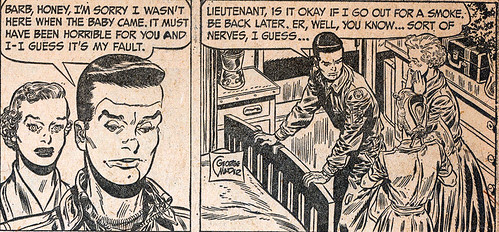 Please amuse yourselves with these out-of-context comic panels I found on the back of a newspaper clipping at work (ca. 1950s, I believe). And revel in the horror of the freaky faces on the one pictured above. I don't know if the man's bizarre browline or the woman's death eyes are worse...
Please amuse yourselves with these out-of-context comic panels I found on the back of a newspaper clipping at work (ca. 1950s, I believe). And revel in the horror of the freaky faces on the one pictured above. I don't know if the man's bizarre browline or the woman's death eyes are worse...
Monday, November 12, 2007
Art vs. Life
 Am I the only one who has noticed that the much discussed story of the guy who made a website to track down a girl he spotted on the subway bears an uncanny resemblance to the plot of 'N Sync's 2001 floppola movie On the Line (just replace websites with billboards since we apparently didn't have the internet in 2001)? Let me note for the record that I only know this because the CW played On the Line as their Sunday afternoon movie a couple of months ago, and I was briefly intrigued.
Am I the only one who has noticed that the much discussed story of the guy who made a website to track down a girl he spotted on the subway bears an uncanny resemblance to the plot of 'N Sync's 2001 floppola movie On the Line (just replace websites with billboards since we apparently didn't have the internet in 2001)? Let me note for the record that I only know this because the CW played On the Line as their Sunday afternoon movie a couple of months ago, and I was briefly intrigued.The casting of On the Line is particularly hilarious as Lance Bass (who later came out as a gay man) plays the romantic lead, but Justin Timberlake (who later Brought Sexy Back) has a very minor role as a gay hairdresser.
[And just to tie it all together, here is a fanfiction video made of stills from Harry Potter movies that brings the plot of the 'N Sync movie to Hogwarts (with help from Ashley Tisdale, who I never heard of, but who is apparently in High School Musical).]
Saturday, November 10, 2007
Colonial Travelers in Latin America
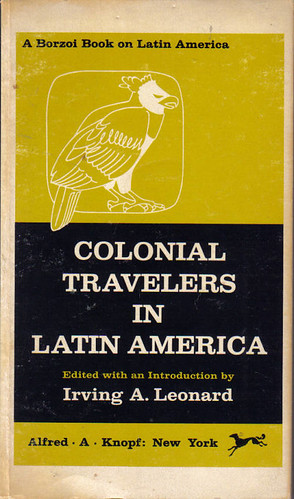 I bought my copy of Colonial Travelers in Latin America, edited by Irving A. Leonard (1972) when I was in college. And thanks to the wonders of my random book reading system, I have finally gotten around to reading it. I have to admit, it does look a little boring on the outside, which is probably why I hadn't read it up until now.
I bought my copy of Colonial Travelers in Latin America, edited by Irving A. Leonard (1972) when I was in college. And thanks to the wonders of my random book reading system, I have finally gotten around to reading it. I have to admit, it does look a little boring on the outside, which is probably why I hadn't read it up until now.At the time that I bought it, I was fascinated with the conquest of the Americas by the Spanish, particularly the stupendous memoir by Cabeza de Vaca about his doomed expedition to Florida in 1528 and his journey through the present-day Southeastern US and Mexico before making his way back to Europe nearly ten years later (the book was also made into a movie, which isn't bad). It really is a great narrative, and I read it multiple times in college and wrote several papers on mister cow head.
So, at the time I was all excited about more contemporary writings about colonial Latin America. And this book, although I didn't read it until nearly ten years after I bought it, does the trick. Leonard compiles readings from the sixteenth, seventeenth, and eighteenth century, written by men of different nationalities traveling through the Spanish and Portuguese colonies for different reasons (including religion, commerce, and science). The translations are very readable and intriguing, and the selections add color and context to the writings of more well-known colonial writers like Bartolome de las Casas or Cabeza de Vaca. Rather than being overly political or religious in their observations, the writers in this collection give detailed descriptions of everyday life in the colonies over three centuries. We get notes on clothing, food (one writer is very impressed with potatoes, after having them for the first time), the social relationships, the women, the natives, the slaves, the modes of travel, and the personalities of the different peoples.
If you have any interest in this period of history in the Americas, then you won't go wrong by checking out Leonard's anthology.
Friday, November 09, 2007
Drink it
 The new pomegranate/blueberry juice from Minute Maid is really great. You should drink some! Now enjoy a press release about the juice from a site that features "Global Fresh Produce and Banana News."
The new pomegranate/blueberry juice from Minute Maid is really great. You should drink some! Now enjoy a press release about the juice from a site that features "Global Fresh Produce and Banana News."That is all.
Tuesday, November 06, 2007
Virtuous
Monday, November 05, 2007
Second Stage Lensmen
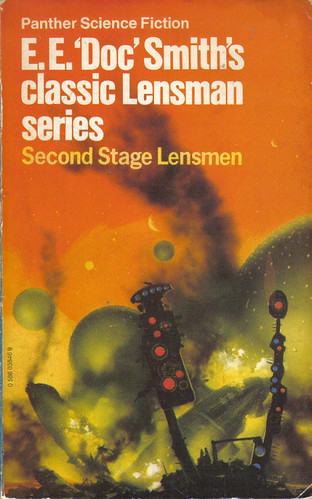 I love the lensman books. Love love love them. And I extra- special loved Second Stage Lensmen (1953), the fifth book in the series.
I love the lensman books. Love love love them. And I extra- special loved Second Stage Lensmen (1953), the fifth book in the series.This book starts one second after the last book leaves off, with our hero Kim Kinnison and his lovely lady-friend, the brave and smart and beautiful Clarissa MacDougal basking in the glow of finally deciding to get married. Since Kim just saved the universe, it shouldn't be a problem, right?
Wrong.
Kim gets a mind-beam from his Mentor on Arisia telling him to think a little harder about his plan to get all the bad guys. It turns out they go much higher up than Kim had originally thought, and if he were to abandon his post and get married now, they would most certainly attack and destroy the earth.
So: Kim gets back to business. Clues first lead him to an Earth-like planet in an unexplored section of the universe. He gets ready to make a landing when he realizes that the entire planet is filled with women -- tall, beautiful, strong women, who don't wear any clothes, measure everything by its efficiency, have bred their men into a short animalistic subspecies that they use only for breeding, and have really bad haircuts:
But she wore no jewelry, no bracelets, no ribbons; no decoration of any sort of kind. No paint, no powder, no touch of perfume. Her heavy, bushy eyebrows had never been plucked or clipped. Some of her teeth had been expertly filled, and she had a two-tooth bridge that would have done credit to any Tellurian dentist -- but her hair! It, too, was painfully clean, as was the white scalp beneath it, but aesthetically it was a mess. Some of it reached almost to her shoulders, but it was very evident that whenever a lock grew long enough to be a bother, she was wont to grab it and hew it off, as close to the skull as possible with whatever knife, shears, or other implement came readiest to hand.
[This reminds me that I need a haircut.]
In order to obtain information about how this key planet fit into the schemes of the bad guys, Clarissa is made into the very first female Lensman. So at least the two of them can lens each other and have telepathic conversations across the depths of space, even if they can't get married....
All kinds of exciting things happen, and eventually Kim decides to go undercover and infiltrate the upper levels of the Boskonian bad-guy leadership. To do this he takes on the identity of a soldier that matches his body type. After some painstaking work to change the archival record (which is later tested for forgery by the head of the bad guys), plus some magic mind work on anyone who ever knew the ex-soldier, Kim takes his place, rises through the ranks, and does just about as well as you might expect the hero of a space opera to do.
Sunday, November 04, 2007
Friday, November 02, 2007
Los Angeles
 Los Angeles Plays Itself (2003, directed by Thom Andersen) is an amazing documentary on the history of Los Angeles, film making, architecture, popular culture, the director's life, what Los Angeles looks like in the movies, what it looks like when it is pretending to be someplace else, what it really looks like, and about a million other things. It is also really really really great. If you are in Austin on November 14th, you should go see it at the Ritz.
Los Angeles Plays Itself (2003, directed by Thom Andersen) is an amazing documentary on the history of Los Angeles, film making, architecture, popular culture, the director's life, what Los Angeles looks like in the movies, what it looks like when it is pretending to be someplace else, what it really looks like, and about a million other things. It is also really really really great. If you are in Austin on November 14th, you should go see it at the Ritz.
Thursday, November 01, 2007
Boo-ter
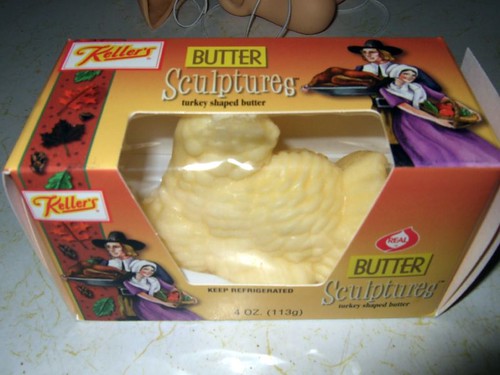 This turkey-shaped butter sculpture truly was the scariest thing I observed during the Halloween festivities this week (most of which went undocumented, but some of which are pictured here). In addition, I love my sister's costume this year, and I think I'm going to copy it one of these days. Now I need to hit that giant Halloween store in the hancock center to scoop up awesome deals for next year's festivities. Halloween -- it is the best holiday we have.
This turkey-shaped butter sculpture truly was the scariest thing I observed during the Halloween festivities this week (most of which went undocumented, but some of which are pictured here). In addition, I love my sister's costume this year, and I think I'm going to copy it one of these days. Now I need to hit that giant Halloween store in the hancock center to scoop up awesome deals for next year's festivities. Halloween -- it is the best holiday we have.
Subscribe to:
Comments (Atom)
